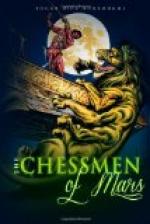“He says not,” returned John Carter.
The girl dismissed the subject with a shrug and the conversation passed to other topics. A letter had arrived from Thuvia of Ptarth, who was visiting at her father’s court while Carthoris, her mate, hunted in Okar. Word had been received that the Tharks and Warhoons were again at war, or rather that there had been an engagement, for war was their habitual state. In the memory of man there had been no peace between these two savage green hordes—only a single temporary truce. Two new battleships had been launched at Hastor. A little band of holy therns was attempting to revive the ancient and discredited religion of Issus, who they claimed still lived in spirit and had communicated with them. There were rumors of war from Dusar. A scientist claimed to have discovered human life on the further moon. A madman had attempted to destroy the atmosphere plant. Seven people had been assassinated in Greater Helium during the last ten zodes, (the equivalent of an Earth day).
Following the meal Dejah Thoris and The Warlord played at jetan, the Barsoomian game of chess, which is played upon a board of a hundred alternate black and orange squares. One player has twenty black pieces, the other, twenty orange pieces. A brief description of the game may interest those Earth readers who care for chess, and will not be lost upon those who pursue this narrative to its conclusion, since before they are done they will find that a knowledge of jetan will add to the interest and the thrills that are in store for them.
The men are placed upon the board as in chess upon the first two rows next the players. In order from left to right on the line of squares nearest the players, the jetan pieces are Warrior, Padwar, Dwar, Flier, Chief, Princess, Flier, Dwar, Padwar, Warrior. In the next line all are Panthans except the end pieces, which are called Thoats, and represent mounted warriors.
The Panthans, which are represented as warriors with one feather, may move one space in any direction except backward; the Thoats, mounted warriors with three feathers, may move one straight and one diagonal, and may jump intervening pieces; Warriors, foot soldiers with two feathers, straight in any direction, or diagonally, two spaces; Padwars, lieutenants wearing two feathers, two diagonal in any direction, or combination; Dwars, captains wearing three feathers, three spaces straight in any direction, or combination; Fliers, represented by a propellor with three blades, three spaces in any direction, or combination, diagonally, and may jump intervening pieces; the Chief, indicated by a diadem with ten jewels, three spaces in any direction, straight, or diagonal; Princess, diadem with a single jewel, same as Chief, and can jump intervening pieces.
The game is won when a player places any of his pieces on the same square with his opponent’s Princess, or when a Chief takes a Chief. It is drawn when a Chief is taken by any opposing piece other than the opposing Chief; or when both sides have been reduced to three pieces, or less, of equal value, and the game is not terminated in the following ten moves, five apiece. This is but a general outline of the game, briefly stated.




